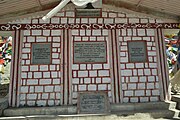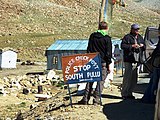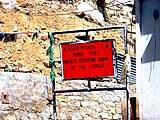Khardung La
This article needs additional citations for verification. (March 2017) |
| Khardung La | |
|---|---|
| Tibetan: མཁར་གདོང་ལ་ | |
| Elevation | 5,359 m (17,582 ft) |
| Location | Ladakh, India |
| Range | Himalaya, Ladakh Range |
| Coordinates | 34°16′42″N 77°36′15″E / 34.27833°N 77.60417°E |
Khardung La (Tibetan: མཁར་གདོང་ལ་, Wylie: mkhar gdong la, THL: khar dong la) or Khardung Pass is a mountain pass in the Leh district of the Indian union territory of Ladakh.
The pass is on the Ladakh Range, north of Leh, and connects the Indus river valley and the Shyok river valley. It also forms the gateway to the Nubra Valley, beyond which lies the Siachen Glacier. A motorable road through the pass was built in 1976, and opened to public motor vehicles in 1988. Maintained by the Border Roads Organisation, the pass is strategically important to India as it is used to carry supplies to the Siachen Glacier. The road is one of the world's highest motoroable roads.[1]
The elevation of Khardung La is 5,359 m (17,582 ft).[2] Local summit signs and dozens of stores selling shirts in Leh incorrectly claim its elevation to be in the vicinity of 5,602 m (18,379 ft) and that it is the world's second highest motorable pass.
Civilian Usage
[edit]Mr. and Mrs. Yoganad are the first civilians to reach Khardung la top.
History
[edit]Khardong La is historically important as it lies on the major caravan route from Leh to Kashgar in Central Asia. About 10,000 horses and camels used to take the route annually, and a small population of Bactrian camels can still be seen at Hunder, in the area north of the pass. In the early 1950s, William O. Douglas described "the trail, after crossing the Indus, divides, one fork going south along the river's edge to Spitok, Khalatse and Khargil, the other turning north to Leh, the Khardong Pass (...), and Yarkand, an ancient trading center of Sinkiang."[3] He continues, "Leh is on a historic caravan route that leads not only to Yarkand in Sinkiang but to Lhasa in Tibet. (...) the stream of trade. Wool, silver, felts, tea, candy, skins, velvets, silk, gold, carpets, musk, coral, borax, jade cups, salt came down from the north. Cotton goods, shawls, brocades, opium, indigo, plumes, shoes, pearls, ginger, cloves, pepper, honey, tobacco, sugar cane, barley rice, wheat, corn came up from the south."[4] During World War II there was an attempt to transfer war material to China through this route.[citation needed]
Location
[edit]-
A memorial at Khardung La
-
Khardung La office and shop
-
Police Check Post, South Pullu Pass, Ladakh
-
Khardung La - Highest Souvenir Shop in the World sign
-
North Pullu sign
-
Peak above Khardung La
Khardung La is 39 km by road from Leh. Earlier, the first 24 km, as far as the South Pullu check point, were paved. From there to the North Pullu checkpoint about 15 km beyond the pass the roadway was primarily loose rock, dirt, and occasional rivulets of snow melt. Now, all the way is properly paved. The road approaching the Nubra Valley is very well maintained (except in a few places where washouts or falling rock occur). Hired vehicles (two and four-wheel-drive), heavy trucks, and motorcycles regularly travel into the Nubra Valley, though special permits are required to be arranged for travellers.
The 5,359 m (17,582 ft) elevation measure from hundreds of GPS surveys matches SRTM data, ASTER GDEM data, and Russian topographic mapping. It is broadly consistent with numerous GPS reports.
The nearest sizable town is Leh. Leh is connected by road from Manali and Srinagar, and daily flights are operated from Delhi. From Leh, a daily bus service to Nubra Valley passes over Khardung La which may also be reached by a hired car with an experienced driver or by motorcycle. The two bases on either side of Khardung La are North Pullu and South Pullu.
An Inner Line Permit (ILP), which can be acquired at the District Commissioner's office in Leh, is required for tourists (not needed for Ladakh citizens). People are required to check in en route and must provide photocopies of the permits to be deposited at each checkpoint.
Altitude sickness is a serious health concern for people not acclimatised to high altitudes. From 2022 minimum two days mandatory acclimatisation in Leh is required before crossing the pass [5] Preventive medication, i.e. acetazolamide, can be used in this period to boost acclimatisation.
The road is often subject to long delays due to traffic congestion on narrow one-lane sections, washouts, avalanches and road accidents, but with no permanent winter closure. Updates on road conditions can be found at the official Leh site.[6]
Climate
[edit]Khardung La has an arctic tundra climate (ET) with short, cool summers and long, very cold winters.
| Climate data for Khardung La | |||||||||||||
|---|---|---|---|---|---|---|---|---|---|---|---|---|---|
| Month | Jan | Feb | Mar | Apr | May | Jun | Jul | Aug | Sep | Oct | Nov | Dec | Year |
| Mean daily maximum °C (°F) | −19 (−2) |
−18 (0) |
−14 (7) |
−11 (12) |
−5 (23) |
1 (34) |
7 (45) |
7 (45) |
1 (34) |
−8 (18) |
−14 (7) |
−18 (0) |
−8 (19) |
| Mean daily minimum °C (°F) | −36 (−33) |
−34 (−29) |
−31 (−24) |
−25 (−13) |
−15 (5) |
−9 (16) |
−6 (21) |
−6 (21) |
−10 (14) |
−18 (0) |
−25 (−13) |
−31 (−24) |
−20 (−5) |
| Average precipitation mm (inches) | 29 (1.1) |
41 (1.6) |
53 (2.1) |
38 (1.5) |
28 (1.1) |
9 (0.4) |
9 (0.4) |
8 (0.3) |
8 (0.3) |
8 (0.3) |
13 (0.5) |
22 (0.9) |
266 (10.5) |
| Source: [7] | |||||||||||||
Gallery
[edit]-
Khardung La in winter
-
Khardung village (right), the namesake of the pass
-
The claimed 5,602 metres (18,379 ft); the actual elevation is 5,359 metres (17,582 ft).
-
Approach from Indus Valley
-
Khardung La road through the rocks
See also
[edit]References
[edit]- ^ "Top 13 Highest Motorable Passes or Roads in the World". 5 February 2015.
- ^ "DGPS Document supplied by the Cartographic Institute of Catalonia" (PDF).
- ^ Douglas, William O. (William Orville), 1898-1980. (1953). Beyond the High Himalayas. [An account of a journey to Afghanistan and Ladakh.] London. OCLC 559521308.
the trail, after crossing the Indus, divides, one fork going south along the river's edge to Spitok, Khalatse and Khargil, the other turning north to Leh, the Khardong Pass (18, 380 feet), and Yarkand, an ancient trading center of Sinkiang.
{{cite book}}: CS1 maint: multiple names: authors list (link) CS1 maint: numeric names: authors list (link) - ^ Douglas, William O. (William Orville), 1898-1980. (1953). Beyond the High Himalayas. [An account of a journey to Afghanistan and Ladakh.] London. OCLC 559521308.
Leh is on a historic caravan route that leads not only to Yarkand in Sinkiang but to Lhasa in Tibet. (...) the stream of trade. Wool, silver, felts, tea, candy, skins, velvets, silk, gold, carpets, musk, coral, borax, jade cups, salt came down from the north. Cotton goods, shawls, brocades, opium, indigo, plumes, shoes, pearls, ginger, cloves, pepper, honey, tobacco, suger cane, barley rice, wheat, corn came up from the south.
{{cite book}}: CS1 maint: multiple names: authors list (link) CS1 maint: numeric names: authors list (link) - ^ "48 hours acclimatization for tourists arriving in Leh. | District Leh, Union Territory of Ladakh | India".
- ^ "Weather and Road Status | District Leh, Union Territory of Ladakh | India".
- ^ "Simulated historical climate & weather data for Khardūng La". meteoblue.












